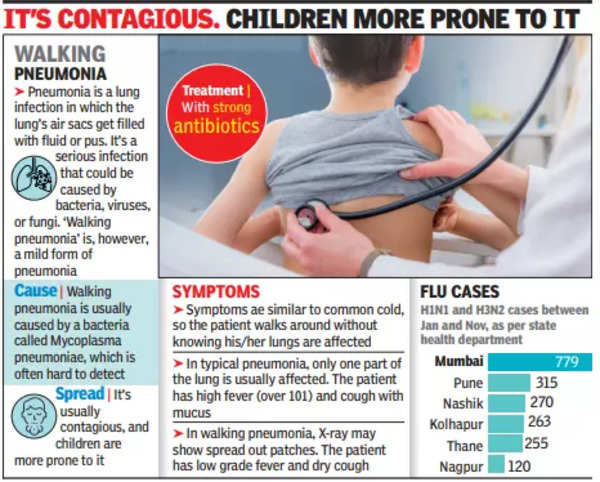
‘Walking pneumonia’ cases rise amid seasonal flu spike in Mumbai | Mumbai News

MUMBAI: With temperatures dropping and the season of sniffles setting in, city doctors are reporting a rise in an unusual entity in the city-walking or mild pneumonia-in the past couple of weeks.

Walking pneumonia seems like a persistent cold and cough, and patients can continue with their routines. However, a small percentage of these patients could develop full-fledged pneumonia, which typically needs hospital admission and care.
“Right now, I am seeing children and adults coming in with community-acquired bacterial infection that is known as walking pneumonia,” said infectious diseases specialist Dr Vasant Nagvekar. Walking pneumonia is also called atypical pneumonia as it is caused by the bacterium Mycoplasma pneumoniae and not usual bacteria, viruses, and fungi; walking pneumonia also cannot be treated with the usual antibiotics, and needs stronger antibiotics.
It’s not easy to detect, but the availability of certain rapid tests in the last couple of years has changed that. “Affluent patients coming to well-known hospitals don’t mind spending Rs 10,000 to Rs 15,000 on tests that can detect organisms affecting them,” said a senior doctor. “Moreover, these tests give results in a couple of hours, resulting in patients starting on the right medication at the earliest.”
Walking pneumonia is not worrisome, but doctors in the city don’t suspect the condition as it’s not usually seen in patients here. Delhi, with its high level of air pollution, has been reporting it for a few years.
Dr Nagvekar said X-ray reports of a few of his patients showed an infection of the upper lung lobes that is typical of tuberculosis. “But further tests revealed that it wasn’t the TB bacillus but Mycoplasma pneumoniae,” he said. Meanwhile, data released by the state health department showed that Mumbai has the highest cases of influenza A (caused by H1N1 or swine flu and H3N2) this year, followed by Pune and Nashik.
According to the health department, 2,325 influenza patients were found in the state between Jan 1 and Nov 21; of these, 57 people died. Around 45% of these cases (1,055) were from the Mumbai Metropolitan Region, but the region hasn’t reported a single death.
A doctor from a civic hospital said hygiene and hydration would be the best ways to reduce the risk of flu. While the flu vaccine is known to reduce the risk of an infection, there has been poor interest in flu vaccination. The state govt has distributed 45,000-plus flu vaccines in various districts this year for pregnant women and patients with chronic diseases such as diabetes and hypertension, but only 2,608 people have taken them so far.